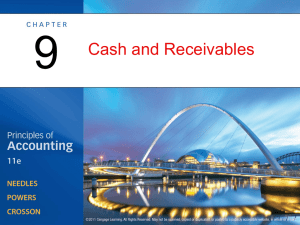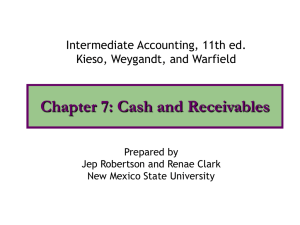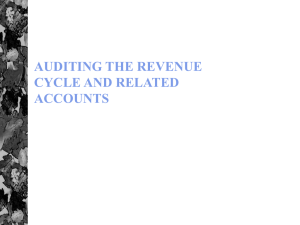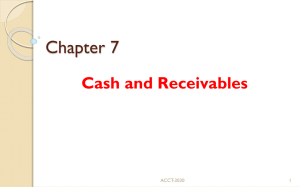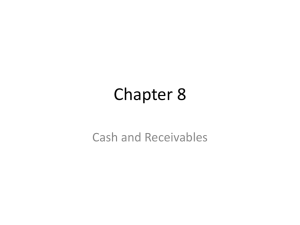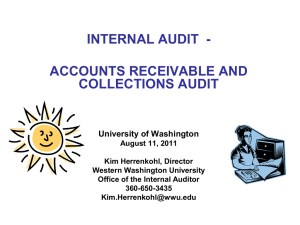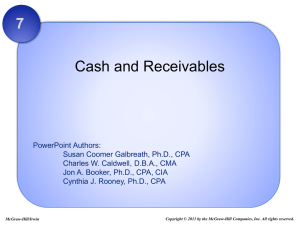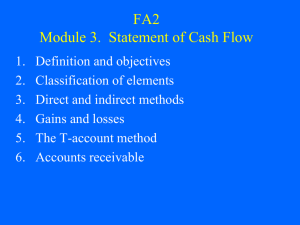FA2 Module 6. Current financial assets and current liabilities
advertisement
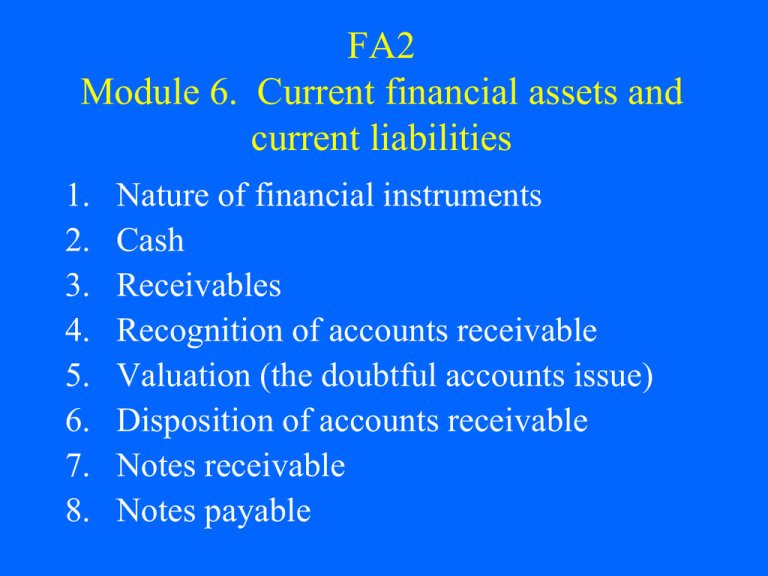
FA2 Module 6. Current financial assets and current liabilities 1. 2. 3. 4. 5. 6. 7. 8. Nature of financial instruments Cash Receivables Recognition of accounts receivable Valuation (the doubtful accounts issue) Disposition of accounts receivable Notes receivable Notes payable 1. Nature of financial instruments A financial instrument is any contract that gives rise to a financial asset of one party and a financial liability or equity instrument of another party. A financial asset is an asset that is: a) Cash b) An equity instrument of another entity. c) A contractual right to (i) receive cash or another financial asset from another party; or (ii) to exchange financial instruments with another party under conditions that are potentially favourable to the entity; or d) A contract that will or may be settled in the entity’s own equity instruments . . . A financial liability is a liability that is a : a) A contractual obligation (i) to deliver cash or another financial asset to another party; or to exchange financial instruments with another party under conditions that are potentially unfavourable to the entity; or b) A contract that will or may be settled in the entity’s own equity instruments . . . Categories of financial assets 1. Amortized cost – financial asset is held to collect contractual cash flows; and the contractual cash flows are solely principal and interest (e. g., loans, receivables) 2. FVTPL (fair value through profit or loss) – other financial assets, plus assets that could be amortized cost but are meant to be sold in the short term or where there is a related or hedged instrument that is FVTPL Amortized cost Item is initially recorded at fair value (transaction value) + any transaction costs incurred. Subsequently measured at amortized cost, which is initial value, minus principal repayment, plus or minus cumulative amortization using effective interest method of any difference between initial amount and maturity amount, less any reduction for impairment or uncollectibility. FVTPL Item is initially recorded at fair value (transaction value). Subsequently measured at fair value, with any gains and losses from change in fair value recognized in earnings. 2. Cash: Composition Cash is currency, funds on deposit in a bank and certain negotiable instruments. • Currency on hand • Petty cash funds • Bank deposits (current or savings accounts) • Cheques, bank drafts, money orders Cash is FVTPL (measured at fair value with any fluctuations reported as gains and losses on the income statement). 2. Cash: Management and control Control of cash is of vital importance in any business because: • Cash can be easily concealed and transported • Everybody wants it (high inherent risk) • Cash is not a productive asset - it is important to maintain sufficient cash to meet current obligations, but no more than necessary Reconciliation of bank balances The balance in the bank account at any given time will often not agree with the balance in the company’s books. A bank reconciliation is an important tool in the control of cash whose object is to identify the items that make up the difference between the balance on the bank statement and the balance of cash according to the depositor’s records (i. e., the items that are recorded by the bank or the depositor, but not both). Typical bank account discrepancies Depositor corrective Depositor Bank action Outstanding cheques Yes No None Deposits in transit Yes No None Depositor errors Yes No Correction Bank service charges No Yes Exp, cash Interest revenue No Yes Rev, cash NSF cheques No Yes Cash, AR Bank errors No Yes Tell bank Item Recorded by: Procedure: Doing a bank reconciliation 1. Compare company deposits to deposits recorded by the bank to identify deposits in transit. 2. Compare cheques written by company to cheques cashed by the bank to identify outstanding cheques. 3. Record all proper bank entries not recorded in company books. 4. Correct any company errors. Note any bank errors. Format of a bank reconciliation Bal. per bank stmt + cash on hand + deposits in transit - outstanding cheques +/- bank errors Correct balance Example: A7-32 Balance per books + revenue from bank - bank service charges +/- other bank dr./cr. +/- depositor errors Correct balance 3. Accounts receivable Receivables Non-derivative financial assets in the form of claims held against customers and others for money (IAS 39). Trade receivables Amounts owed by customers for goods sold and services rendered as part of normal business operations. 3. Accounts receivable Nontrade receivables Receivables that arise from transaction other than sale of products or services that are part of normal business operations (e. g., dividends, tax refunds, loans to employees). 3. Accounts receivable Accounts receivable Oral promises of customer to pay for goods sold or services rendered, usually supported by an invoice or bill, and normally payable within 30 - 60 days. Notes receivable Written promises to pay, potentially arising from many different sorts of transactions; can be short-term or long-term. 4. Recognition of accounts receivable Discounts offered to customers Vendors often offer terms like 2/10, n/30 (2% discount if payment is received within 10 days, otherwise the full amount is due within 30 days). Two methods are used in practice: Gross method: Sales/receivables are recorded at list price; discounts taken are deducted from sales Net method: Sales/receivables recorded at value net of discount; discounts missed are treated as interest income 4. Recognition of accounts receivable Discounts example Vendor Ltd. sells merchandise (list price = $100) on credit to a customer, 2/10, n/30. Prepare journal entries to record the sale and payment under both the gross and net methods, assuming (a) that the customer pays seven days after the merchandise is delivered. (b) that the customer pays 30 days after the merchandise is delivered. 4. Recognition of accounts receivable Nonrecognition of interest Accounts receivable are carried at face value (the amount the customer promises to pay), rather than the present value of the promised payment (amortized cost). This is because: (1) the interest component is probably immaterial; and (2) it is not clear what interest rate should be used in present value calculations. 5. Valuation of accounts receivable Accounts receivable should be valued at net realizable value, the amount of cash the entity expects to collect. Accounting for uncollectible accounts 1. Direct write-off method Uncollectible accounts are written off, and bad debt expense recognized, when it becomes clear that a particular account is uncollectible. Leads to mismatching of expense and rev, and overstates value of AR. Accounting for uncollectible accounts 2. Allowance method Amount of uncollectible accounts (bad debt expense) is estimated and recorded in the year in which credit sales occur. Dr. Bad debt expense Cr. Allowance for doubtful accounts When a particular account is uncollectible, Dr. Allowance for doubtful accounts Cr. Accounts receivable Estimating bad debt expense 1. Balance sheet approach/Aging method Year-end accounts receivable are analyzed and an estimate made of the amount of uncollectible accounts (e. g., percentage of total accounts receivable , aging analysis, account-by-account analysis). Bad debt expense = required balance in AFDA (per AR analysis) – unadjusted balance in AFDA Example: A7-7 Estimating bad debt expense 2. Income stmt approach/Credit sales method An estimate is made of the amount of this year’s sales that will ultimately be uncollectible, based on company’s experience, economic conditions, etc. Bad debt expense = This year’s (credit) sales x Estimated bad debt percentage Example: A7-7 6. Disposition of accounts receivable To accelerate the conversion of accounts receivable into cash and/or to avoid collection problems, a company can transfer its receivables to another company in exchange for cash. The broad categories of transfer transactions include: 1. Secured borrowing 2. Sale of receivables 1. Secured Borrowing Accounts receivable are designated as collateral for a loan. If the loan is unpaid, the lender has the right to collect the receivables directly from the entity’s customers. General assignment means all receivables are collateral. No specific entry is made to record the transaction (aside from the Cash/Note Payable entry). Information regarding the assignment of accounts receivable is disclosed in a footnote to the financial statements. 2. Sale of receivables Receivables are sold to an outside agency(ies) (e. g., factoring, securitization) that collects directly from the company’s customers (the debtors). Sale or transfer without recourse The purchaser of the receivables assumes the risk of collectibility. Sale or transfer with recourse The seller of the receivables guarantees payment if the debtor fails to pay. Sale without recourse The purchaser assumes all risks of collectibility and absorbs any credit losses. Cash is received from purchaser of AR Dr. Cash Cr. Accounts receivable Dr. Financing expense Purchaser collects AR without problem NO ENTRY in the books of entity which sold the accounts receivable. Sale with recourse We will not deal with that in FA2 Sale or secured borrowing? Derecognition (recording a sale) occurs if and only if one of the following conditions are met: Rights to cash flow from receivables has expired Transferor has no continuing involvement in receivables Transferee (purchaser) is free to retransfer receivables for its own benefit If none of the three are met, the transaction should be treated as a loan. Example: A7-12 (part 1) 7. Notes receivable Notes receivable are similar to accounts receivable in that they represent amounts owed by external entities. Unlike accounts receivable, notes are contracts, typically signed by both parties, that generally specify payment dates and interest rates. They can be trade or non-trade receivables, current or noncurrent, etc. Unlike accounts receivable, the interest rate is often specified and is frequently material. Notes receivable vocabulary Face value (or principal): This is the amount written on the face of the note and represents the total amount that will be paid by the debtor (plus any explicit interest). Interest rate: This is the rate that is written on the face of the note and is used in the calculation of interest payments. Amortized cost: after acquisition, notes are generally measured at amortized cost = initial value – principal repayments +/- amortization of discount/premium – any impairment Types of notes receivable 1. Notes bearing normal interest rate These notes are initially recorded at face value which is equal to present value of implied future cash flows. 2. Notes bearing abnormal (usually, low or zero) interest rates These notes are valued at their fair market values, which is the present value of the implied cash flows discounted at a normal interest rate. With notes like this, face value is not equal to fair value. Recording notes receivable 1. Notes bearing normal interest rates Dr. Note receivable Face value (Face) Cr. Revenue (or whatever) Face If the note is bearing a “normal” interest rate (i. e., the rate at which we would discount the future cash flows in computing the present value), the present value of the implied cash flows is equal to the face value of the note. Recording notes receivable 2. Notes bearing abnormal (low or zero) interest rates Net method Dr. Note receivable PV of cash flows Cr. Revenue (or whatever) PV Gross method Dr. Note receivable Face value (Face) Cr. Discount on note receivable (Face-PV) Cr. Revenue (or whatever) PV 8. Notes payable Like accounts payable, notes payable are amounts owed to external parties. Unlike accounts payable, notes payable are contracts, typically signed by both parties, that generally specify payment dates and interest rates. The interest rate on a note payable is often specified and is frequently material. Accounting for notes payable is just like accounting for notes receivable, but from the borrowers’ point of view. Example: A7-20

